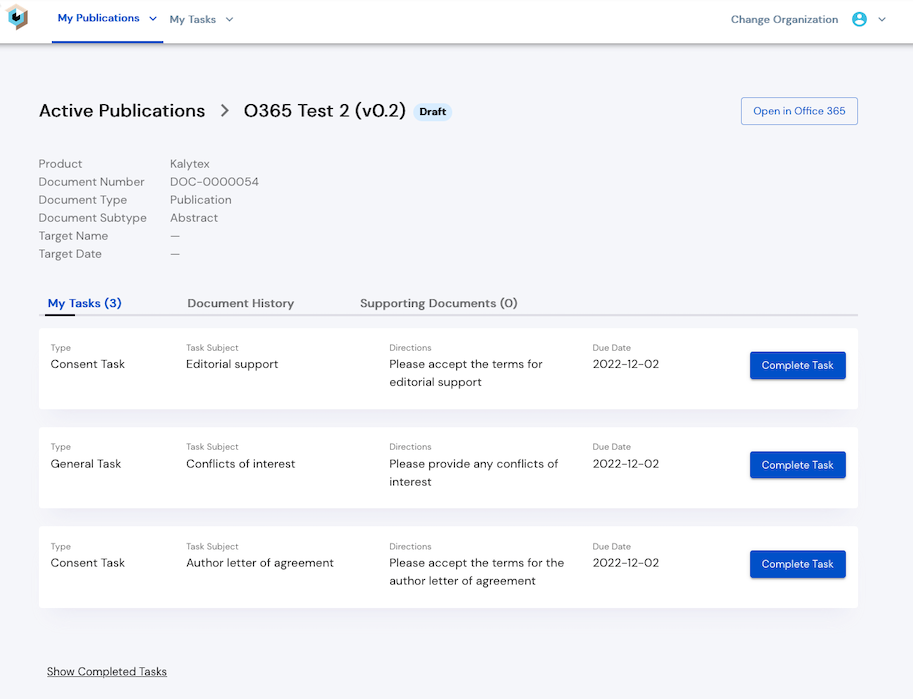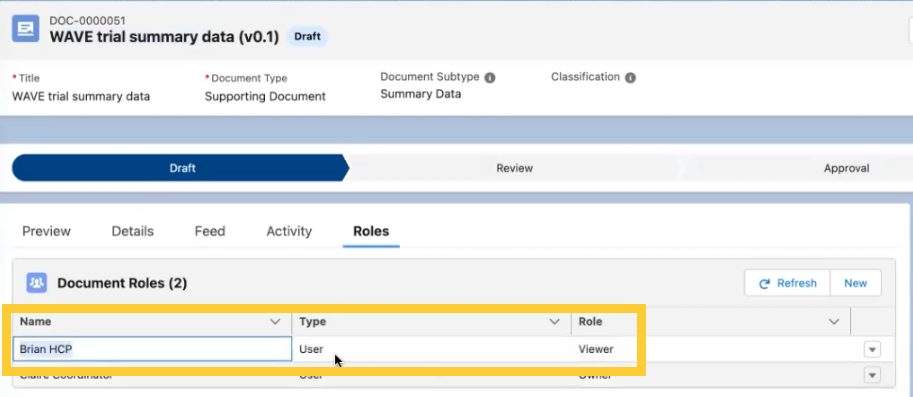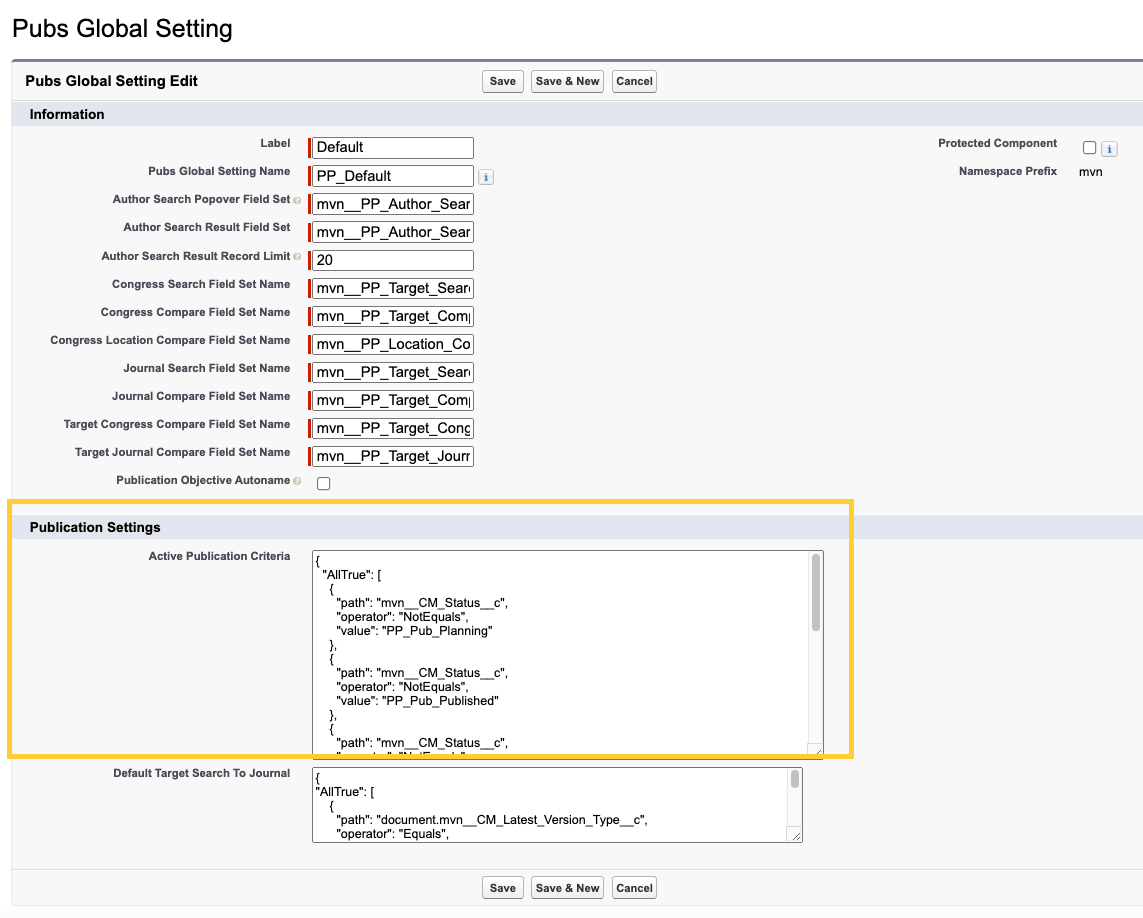Collaborator Portal
The Collaborator Portal combines the back-end functionality of Salesforce with a user-friendly AWS front-end experience. This combination provides a streamlined user interface that enables individuals to easily collaborate on documentation, including reviewing and completing assigned document-related tasks.

(Optional prerequisite) Set up and configure Microsoft 365
If you plan on enabling Microsoft 365 in the Collaborator Portal, make sure that Microsoft 365 is set up and configured appropriately before you set up the Collaborator Portal. To do so:
Integrate your Salesforce environment with Microsoft 365. For detailed instructions, reference the Microsoft 365 page.
In Setup, search for and select Manage Connected Apps.
Edit the MCM Office 365 app if you're in a production environment and the MCM Office 365 (Test) app if you're in a test environment.
Under the Custom Connected App Handler section on the Apex Plugin Class field, enter
mvn.PP_Office365ConnectedAppPlugIn.Click Save.
Set up and update the Collaborator Portal
The Collaborator Portal is available in the mvn-publications-planning-identity package and requires that a Salesforce Digital Experience (formerly called Communities) is enabled for your organization.
Note
On your behalf, Komodo Health's delivery team will set up and update the Collaborator Portal for your Salesforce environment as appropriate. You do not need to complete the following steps.
To set up a new instance of the Collaborator Portal:
Install the
mvn-publications-planning-identitypackage.Enable the Salesforce Digital Experience. For more information, reference Salesforce's documentation on how to Enable the Experience Cloud Site in Your Org.
Add the mvn__Login Visualforce page. For more information, reference Salesforce's documentation on how to Use Visualforce in Experience Builder Sites.
Warning
If you want to customize the login page for the Collaborator Portal, you may create your own Visualforce page. Do not edit the out-of-the-box mvn__Login Visualforce page. For more information, reference Customization guidelines.
(Optional) Configure a custom domain. For more information, reference Salesforce's documentation on how to Configure a Custom Domain for Your Experience Cloud Site.
Warning
A production domain must be created in order to host the Collaborator Portal community.
Provide the Publications Management product team with the Collaborator Portal URL. This will enable the product team to generate a portal identity provider to be used in step 5b and a branch domain URL for a new origin URL pattern to be used in step 7.
To find the Collaborator Portal URL:
In Setup, search for and select All Sites.
In the Collaborator Portal row, find the link under the URL column. This is the URL to provide to the Publications Management product team.
The Publications Management product team will complete several setup steps on their end and provide both the portal identity provider and the branch domain URL in return.
Enable Microsoft 365 in the Collaborator Portal. To do so, you must create a new custom attribute on the Office 365 Connected App and then add the portal identity provider to the Default Microsoft 365 Setting metadata record.
Warning
To enable Microsoft 365 in the Collaborator Portal, make sure you have completed the prerequisite steps in the (Optional prerequisite) Set up and configure Microsoft 365 section above.
To create a new custom attribute on the Office 365 Connected App:
From Setup, navigate to Manage Connected Apps.
Click the existing MCM Office 365 app if you're in a production environment and MCM Office 365 (Test) app if you're in a test environment.
Scroll down to the Custom Attributes section, and click New.
In the Attribute key field, enter
mvn__CA_O365_ExperienceSite.In the Attribute value field, enter the following code and substitute
<communityUrl>with the Collaborator Portal URL for your instance.If(ISPICKVAL($User.UserType,"PowerCustomerSuccess"),"<communityUrl>","")
Warning
The URL of the Collaborator Portal that should be added to
<communityUrl>is not the same as the URL of the Salesforce environment. In other words, the URL that is entered for the<communityUrl>should open the Collaborator Portal and not the Salesforce environment.Click Save.
To add the portal identity provider to the Default Microsoft 365 Setting metadata record:
From Setup, navigate to the Microsoft 365 Setting (
mvn__CA_Office_365_Setting__mdt) custom metadata type.Edit the Default (
Default) metadata record.In the Portal Identity Provider field, enter the provider name that the Publications Management product team provided in step 4b.
Note
If the Portal Identity Provider field is not readily available in the Office 365 Setting layout, edit the layout and add the field.
Click Save.
Enable Cross-Origin Resource Sharing (CORS). For more information, reference Salesforce's documentation on how to Enable CORS for OAuth Endpoints.
Add the branch domain URL that the Publications Management product team provided in step 4b as a new origin URL pattern to the CORS. This will allow the AWS instance to communicate with Salesforce. For more information, reference Salesforce's documentation on how to Configure Salesforce CORS Allowlist.
Add the Collaborator Portal landing page URL to the Default Collaborator Portal metadata record. This will ensure that users in the Collaborator Portal are directed to the corresponding Salesforce environment.
To configure the Default Collaborator Portal metadata record:
In Setup, navigate to the Collaborator Portal (
mvn__PP_Collaborator_Portal__mdt) custom metadata type.Edit the Default (
PP_Default) metadata record.Set the Portal Landing URL field to equal the Collaborator Portal landing page URL, or the URL of the AWS instance.
(Optional) Set the Static Resource Name field. For more information, reference the Customize UI with static resources section below.
Click Save.
The setup of a new instance of the Collaborator Portal is now complete. To update an existing instance of the Collaborator Portal, upgrade the mvn-publications-planning-identity package.
Change Collaborator Portal versions in sandbox environments
You can use different versions of the Collaborator Portal in sandbox environments. This allows you to try out the features in the latest version and compare them with existing features without having to upgrade the Collaborator Portal instance that is associated with your production Publications Management Salesforce environment.
To enable the ability to change Collaborator Portal versions, add the following URLs to the cross-origin resource sharing (CORS) list of your sandbox environment. Each URL corresponds to a specific Collaborator Portal version and, therefore, a specific Publications Management version. For more information, reference Salesforce's documentation on Configure Salesforce CORS Allowlist:
URL | Collaborator Portal version | Publications Management version |
|---|---|---|
current.test.pub.komodohealth.com |
| Fall '24 |
previous.test.pub.komodohealth.com |
| Spring '24 |
deprecated.test.pubs.komodohealth.com |
| Fall '23 |
To change the Collaborator Portal version in a sandbox environment:
In Setup, navigate to the Pubs API Version (
mvn__PP_Pubs_API_Version__mdt) custom metadata type.On the Pubs API Version 2.00 (
PP_Pubs_API_Version_2) metadata record, modify the Portal API Version (mvn__PP_Portal_API_Version__c) and Pubs API Version (mvn__PP_Pubs_API_Version__c) fields to the desired Collaborator Portal version from Table 140, “Collaborator Portal version URLs” above.
Once configured, you may have to open the Collaborator Portal in an incognito window. The URL of the Collaborator Portal will update accordingly based on the version.
Collaborator Portal users
Collaborator Portal users are designated using the following taxonomies:
Object | Definition |
|---|---|
Contact | The Contact object stores initial metadata about each Collaborator Portal user. This information allows you to create document collaborators, relate them to documents, and perform background checks prior to provisioning them access to the Collaborator Portal. Required fields include:
|
Document Collaborator | A Contact record can be related to a Document ( Required fields include:
|
User Request | A User Request ( The scheduled job will also activate all related Document Collaborator records, thereby providing document collaborators access to the publication document based on their role. For more information about the PP_NewUserRequestSchedulable scheduled job, reference Schedulable jobs. For more information on how to configure a passwordless login for new users, reference Enable passwordless login. |
User | A User record is created for each Document Collaborator record that has been provisioned. Every document collaborator must have a User record to log into the Collaborator Portal. NoteEvery document collaborator only needs to be provisioned once. Once a user is provisioned for a related contact, the document collaborator can be added to any other publication document. Required fields include:
Optional fields include:
|
Create a new user
To create a new user for the Collaborator Portal, you must complete three primary steps:
Create a Contact record.
Create a Document Collaborator record and therefore relate the Contact record to a Document record.
Provision the document collaborator, which runs a batch process that creates a User Request record and automatically activates the document collaborator. This means that the user will gain access to the documents to which they are added as a collaborator. For more information about provisioning users, reference the Provision a user section below. For more information about creating users and adding permissions, visit the Users page.
Note
If the Contact record already has a related User record, disregard this step. The Document Collaborator record can be activated manually by the user.
Provision a user
To provision a user:
From the Document record page, click the Collaborators tab.
Click the dropdown caret next to the contact or document collaborator you want to provision.
Select Provision User.
On the Provision User modal, ensure all the details are correct.
Click Provision User.
After the user provisioning batch process is run, the document collaborator will be activated with a User record. They will receive an email that instructs them on how to set up their Collaborator Portal account and can then be added as an active collaborator to any future documents.
Note
Salesforce automatically generates the usernames for Collaborator Portal users. The user only needs their email address to log in and either reset their password or receive and submit a verification code. For more information about passwordless login for the Collaborator Portal, reference the Enable passwordless login section below.
Warning
If enhanced domains are enabled in your Salesforce environment and an external document collaborator runs into an error when logging into the Collaborator Portal:
In Setup, search for and select Network Access.
Create the following Trusted IP Range records:
Start IP Address
End IP Address
0.0.0.0
1.255.255.255
2.0.0.0
3.255.255.255
In Setup, search for and select Profiles.
Click the external collaborator who is unable to log into the Collaborator Portal.
Create the following Login IP Range record:
IP Start Address
IP End Address
0.0.0.0
255.255.255.255
The external collaborator will no longer run into an error when logging into the Collaborator Portal.
Just-in-time provisioning
"Just-in time provisioning" is the process in which users who are added to a publication document can be provisioned by viewing and downloading related supporting documents in the Collaborator Portal. The users who can be provisioned with this process must be assigned a role that is configured for the specific supporting document type on the publication document. For more information, reference the Configure supporting document types section below.
To trigger the just-in-time provisioning task, users can download a supporting document in the Collaborator Portal. After Salesforce processes the request, the user will appear in the Document Roles related list in the Salesforce environment.

Permissions
Access to the Collaborator Portal, including the ability to view documents, complete tasks, and receive notifications, is governed by the PP_Publication_Collaborator_Externals permission set group, which includes the following permission sets.
Permission set | Description |
|---|---|
PP_Content_Author_External | Users with this permission set have access to publication documents. This permission set should be used in conjunction with the The External Notifications ( |
PP_ContentAuthor_External | Users with this permission set have access to content management objects and fields. This is a clone of the |
PP_App_Permissions_External | Users with this permission set have access to Publications Management application settings, custom metadata, Apex classes, etc. |
CA_Office_365_Author | Users with this permission set can author Microsoft 365 content. |
Collaborator Portal documents
Only certain document types appear in the Collaborator Portal, and whether or not they appear for a user depends on the user's assigned role and permissions. Additionally, configurations must be made to certain custom metadata types in your Salesforce instance to drive how users can interact with the documents. As part of that process, you need to determine what types of documents will be supported. The following sections below define the different document types as well as explain how users can open and download documents to view them through the Collaborator Portal.
Document types
Publication documents
A publication document is any document type or subtype that has a related document collaborator. The Document Collaborator table must be on the high-level Publication Document layout, such as on a manuscript or an abstract. These types of documents subsequently appear in the Collaborator Portal under either Active Publications and Inactive Publications in the My Publications tab. You can configure the types of document statuses that should be considered to be "active" publication documents using the Pubs Global Setting (mvn__PP_Global_Setting__mdt) custom metadata type. For more information, reference the Configure the active publication criteria section below.
To view all of the available active and inactive publications, Collaborator Portal users can toggle between a card view using the grid ( ) icon and a tabular view via the table (
) icon and a tabular view via the table ( ) icon. The card view is the default view and can show certain information about each publication in a more readable way. The tabular view lets users sort the list of publications with any of the available columns but may truncate some information to fit the table. For example, the status label may be truncated in the tabular view but not in the card view; users must hover over the status in the tabular view to read the entire label.
) icon. The card view is the default view and can show certain information about each publication in a more readable way. The tabular view lets users sort the list of publications with any of the available columns but may truncate some information to fit the table. For example, the status label may be truncated in the tabular view but not in the card view; users must hover over the status in the tabular view to read the entire label.
Package files
Package files are a set of one or more files that relate to a single document version. For every publication document that appears in the Collaborator Portal, all of its package files will also appear as long as the Pubs API Version 2.00 (PP_Pubs_API_Version_2) Pubs API Version (mvn__PP_Pubs_API_Version__mdt) metadata record is active. Reference the Package files page for more information.
All package files for a publication document appear in the Related Documents subtab in the Collaborator Portal. Package files are listed above other supporting documents.
Supporting documents
Supporting documents are any types of documents that are configured to be "supporting" for a publication document via the Supporting Document Type (mvn__PP_Support_Document_Type__mdt) custom metadata type. This gives you more flexibility and control over what you want to share with document collaborators. Reference the Configure supporting document types section below for more information.
All supporting documents for a publication document appear in the Related Documents subtab in the Collaborator Portal. Supporting documents are listed under package files.
Open and download documents
If Microsoft 365 has been enabled for the Collaborator Portal, documents with files that meet the Microsoft 365 document requirements can be opened and viewed in Microsoft 365. To open a publication document in Microsoft 365, users can click the  Open Pub button. To open any other related file in Microsoft 365, such as a package file or a supporting document, users can click the
Open Pub button. To open any other related file in Microsoft 365, such as a package file or a supporting document, users can click the  Open File button.
Open File button.
If Microsoft 365 has not been enabled for the Collaborator Portal or if an external document collaborator wants to view a document locally outside of Microsoft 365, users can download the desired files. To download a publication document, users can click the  Pub button. To download a publication document with all of its package files, users can click the
Pub button. To download a publication document with all of its package files, users can click the  Pub & Package Files button. And, finally, to download any other related file, such as an individual package file or supporting document, users can click the
Pub & Package Files button. And, finally, to download any other related file, such as an individual package file or supporting document, users can click the  File button.
File button.
If there is no file to be opened or downloaded or if Microsoft 365 is not enabled in the Collaborator Portal, then the corresponding button(s) will be disabled (i.e., greyed out). For instance, if Microsoft 365 is not enabled or if Microsoft 365 is enabled but the associated file does not meet the document requirements, then the button(s) to open the file in Microsoft 365 will be disabled. Similarly, if there is no file for the publication document, then all of the buttons to open or download the publication document will be disabled.
External documents and files from Google Drive
If an integration with Google Drive through Salesforce's Files Connect service is configured, any external documents or files that are created in the Salesforce instance of Publications Management will appear in the My Publications tab. However, Collaborator Portal users will only be able to view the documents' metadata and cannot open or view the actual files. Additionally, only the package files for the external documents can be downloaded; the document files themselves cannot be downloaded, and users who try to click the  Pub and
Pub and  Pub & Package Files buttons will be thrown the following error message: "You do not have the level of access necessary to perform the operation you requested. Please contact the owner of the record or your administrator if access is necessary."
Pub & Package Files buttons will be thrown the following error message: "You do not have the level of access necessary to perform the operation you requested. Please contact the owner of the record or your administrator if access is necessary."
To enable Collaborator Portal users to open, download, and/or view the files, a snapshot of the external file must be created in the Salesforce org so that a local version of the file is created and stored in Publications Management.
For more information about Files Connect and Google Drive files in Publications Management, reference Files Connect.
Configuration
You can configure the Collaborator Portal in different ways to best meet the needs of your business and users. The following sections provide guidance on how you can configure different aspects of the Collaborator Portal.
Enable passwordless login
External document collaborators must log into the Collaborator Portal to review documents and complete tasks. By default, every external document collaborator is required to set a password when their Collaborator Portal account is first created and to use that password with their email address to log into the Collaborator Portal. However, you can enable passwordless login so that external document collaborators have the option to access the Collaborator Portal with just their email address.
To enable passwordless login so that external document collaborators can log into the Collaborator Portal without setting or entering a password:
In Setup, navigate to the Collaborator Portal (
mvn__PP_Collaborator_Portal__mdt) custom metadata type.Edit the Default (
PP_Default) metadata record.Check the Enable Passwordless Login checkbox field.
Click Save.
Passwordless login for new users
Once passwordless login is enabled, new Collaborator Portal users can then follow the steps below to activate their account without having to set a password:
In the Collaborator Portal welcome email, click Login or the linked URL.
On the Set Password page, click Use Passwordless Login.
On the Welcome page, click click here.
If no default Salesforce login URL has been set, click Change Organization and select the Salesforce organization associated with the Collaborator Portal.
Passwordless login for existing users
After passwordless login is enabled, existing document collaborators who have already set passwords for the Collaborator Portal prior to the Publications Management Fall '24 release need to verify their email addresses to log in without passwords. To prompt existing users to verify their email addresses, you can initiate password resets. You must have the Multi-Factor Authentication for User Interface Logins general user permission to initiate password resets, and you can reset passwords individually or in bulk. For more information about the required permission, reference Salesforce's documentation on Enable MFA for External Experience Cloud Site Users (or Specific Internal Users).
Note
You only need to have the Multi-Factor Authentication for User Interface Logins general user permission on your profile if you are resetting the passwords of existing Collaborator Portal users. You only need to reset every user's password once, and you can remove the MFA general user permission immediately after initiating the password reset.
To reset the password of an individual Collaborator Portal user so that they can verify their email address and use passwordless login:
In Setup, search for and select Users.
Click the name of the Collaborator Portal user.
Click Reset Password.
To reset the passwords of all Collaborator Portal users so that they can verify their email addresses and use passwordless login:
Ensure that the URL of the Collaborator Portal site is populated on the Default Collaborator Portal metadata record.
To find the URL of the Collaborator Portal site:
In Setup, search for and select All Sites.
On the Collaborator Portal row, note the value in the URL column.
To check the Collaborator Portal Name value on the Default Collaborator Portal metadata record:
In Setup, navigate to the Collaborator Portal (
mvn__PP_Collaborator_Portal__mdt) custom metadata type.Open the Default (
PP_Default) metadata record.Confirm that the Collaborator Portal Name (
mvn__PP_Collaborator_Portal_Name__c) field is populated with the URL of the Collaborator Portal site. If not, update the metadata record.
Run the following script:
List<TwoFactorMethodsInfo> twoFactorMethodsInfos = [Select Id, UserId, HasUserVerifiedEmailAddress FROM TwoFactorMethodsInfo]; Map<Id, TwoFactorMethodsInfo> userIdToTwoFactorMethodsInfo = new Map<Id, TwoFactorMethodsInfo>(); Set<Id> userIdsToSendAVerificationEmailTo = new Set<Id>(); for(TwoFactorMethodsInfo tfmi : twoFactorMethodsInfos){ userIdToTwoFactorMethodsInfo.put(tfmi.UserId, tfmi); } List<User> portalUsers = [SELECT ID, Email FROM User WHERE UserType = 'PowerCustomerSuccess' AND isActive = true]; for(User portalUser : portalUsers){ if(userIdToTwoFactorMethodsInfo.containsKey(portalUser.Id) && !userIdToTwoFactorMethodsInfo.get(portalUser.Id).HasUserVerifiedEmailAddress){ userIdsToSendAVerificationEmailTo.add(portalUser.Id); }else if(!userIdToTwoFactorMethodsInfo.containsKey(portalUser.Id)){ userIdsToSendAVerificationEmailTo.add(portalUser.Id); } } Database.executeBatch(new mvn.PP_PortalUserEmailVerificationsBatch(userIdsToSendAVerificationEmailTo), 200);
In the password reset email that is sent out, every Collaborator Portal user can click the linked URL to verify their email address and reset their password as desired. These users can then navigate to the Collaborator Portal and log in without a password, as described below.
Log in without a password
External document collaborators who wish to log into their Collaborator Portal accounts without a password can follow the steps below:
On the Welcome page, click click here.
If no default Salesforce login URL has been set, click Change Organization and select the Salesforce organization associated with the Collaborator Portal.
On the Login To Continue page, enter the email address for the account and click Send Verification Code. Salesforce will send a verification code.
In the "Verify your identity in Collaborator Portal" email, copy the verification code.
On the Enter Your Verification Code page, paste the verification code and click Verify Code.
Under the success message, click Continue.
Collaborator Portal users can click Log In With Password at any time during the login process to use their password instead of a verification code to log in. If an external document collaborator has never set a password, they can click Reset Password to initiate the password creation process.
Customize UI with static resources
You can use static resources to configure the help text, links, and logos in your instance of the Collaborator Portal. For more information about static resources, reference Salesforce's documentation on Static Resources.
Note
If a static resource does not exist or the expected HTML is missing, a comment will appear in the HTML file directing you to the location of the static resource/html.
By default, the Collaborator Portal (mvn__PP_Collaborator_Portal__mdt) custom metadata type uses the PubsIdentity (PP_Pubs_Identity_Resource__c) static resource. You can update the HTML content for the login page in the file attached to the static resource by using the following file paths and editing the file.
html/en-US/login/htmlTop.htmlhtml/en-US/login/htmlBottom.html
For example, you can include a line of text that appears on the bottom of the login page that will direct users to a custom link if they need help.
Configure the active publication criteria
Publications that appear on a document collaborator's instance of the Collaborator Portal are separated into "Active Publications" and "Inactive Publications". To define what is considered to be an "active" publication:
In Setup, navigate to the Pubs Global Setting (
mvn__PP_Global_Setting__mdt) custom metadata type.Edit the Default (
PP_Default) metadata record.Adjust the criteria under the Active Publication Criteria section.
Click Save.

Configure supporting document types
Supporting documents appear in the Related Documents subtab for each publication document in the Collaborator Portal. To configure which types of documents should be considered as supporting document types:
In Setup, navigate to the Supporting Document Type (
mvn__PP_Supporting_Document_Type__mdt) custom metadata type.Click Manage Supporting Document Types.
To edit an existing type, click Edit under the Action column. To add a new type, click New.
Ensure that all fields listed below are completed:
Field label
Description
Label
Enter a label for the document type.
Role
Select a role from the options below. Users with this role will be able to see this document type.
Approver
Owner
Reviewer
Viewer
Publication Specialist
Author
Statistician
Document Type
Select a document type from the following options, including:
Supporting Document
Summary Data
Other
Note
The document type should be appropriate for the selected role. For example, certain roles would not need to see "Other".
Configure task visibility
The "Task: Make Tasks Visible for Community Users" flow determines the visibility of tasks. To configure the logic inside the flow:
In Setup, search for and select Flows.
Click Task: Make Tasks Visible for Community Users. The Flow Builder interface appears.
Edit the flow logic as desired.
Warning
If the Public (IsVisibleInSelfService) field on the Task object is not set to true, Collaborator Portal users will not see other users' review/approval tasks.
Override Microsoft 365 labels
If you use the Microsoft 365 integration in the Collaborator Portal, you can configure the names and actions of the links that appear in a document's file path. To do so:
In Setup, navigate to the Microsoft 365 Setting (
mvn__CA_Office_365_Setting__mdt) custom metadata type.Edit the Default (
Default) metadata record.Verify that the User Overrides Apex Class Name field is populated with
PP_Office365CheckoutUserOverrides.Navigate to the Office 365 Override (
mvn__PP_Office365_Override__mdt) custom metadata type.Add your preferred URL labels and names.
Note
Checking the Use Collaborator Portal URL (
mvn__PP_Use_Collaborator_Portal_URL__c) field (i.e., setting the checkbox totrue) will make the following URLs default to the URL of the Collaborator Portal:Action Return URL
Action URL
Close URL
Values in the above fields will not break anything but will not be used in runtime.
Note
The Close URL value does not appear in the user interface but should contain the URL you want to direct users to when the document is closed.
Warning
If a change is made to the configuration settings while a user(s) is working in a document, the changes will not appear until after the document is checked out again.
For instance, you can configure the Microsoft 365 integration settings so that external document collaborators can click on a specific hyperlink to navigate from a document in Microsoft 365 back to the Collaborator Portal. An example of a file path and its associated settings is shown below.

Troubleshoot login issues
If users are unable to log into the Collaborator Portal, you may troubleshoot and resolve the login issues as follows:
Check that access to Salesforce is not restricted to IPs in specified login IP ranges.
In Setup, search for and select Session Settings.
Under Session Settings, ensure that the "Enforce login IP ranges on every request" checkbox is not checked. Modify the setting as needed.
Check that there are no login IP ranges specified in the users' profiles. The login IP range setting is used to restrict IPv4 addresses, not IPv6 addresses, which the users may have.
In Setup, search for and select Profiles.
Select the profile(s) of the users who are unable to log into the Collaborator Portal.
Under the Login IP Ranges section, delete any existing records.